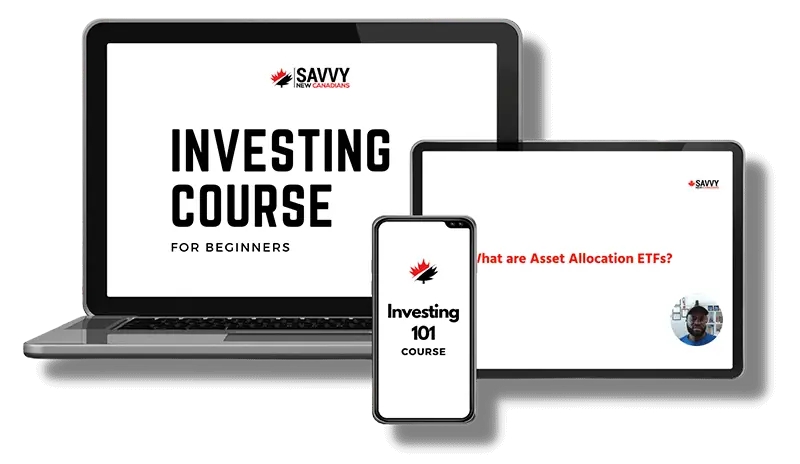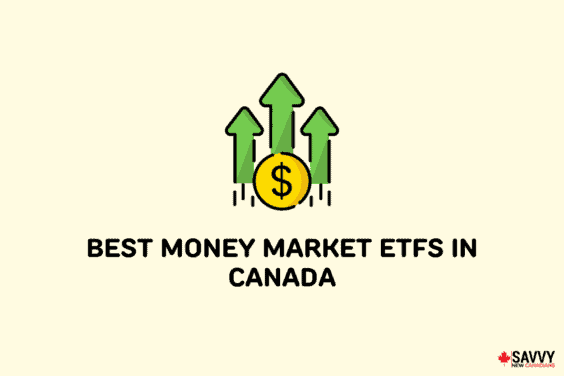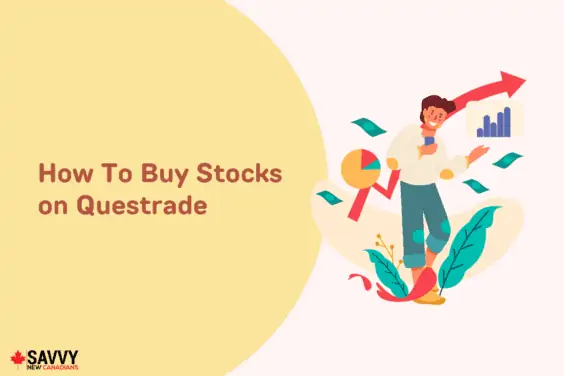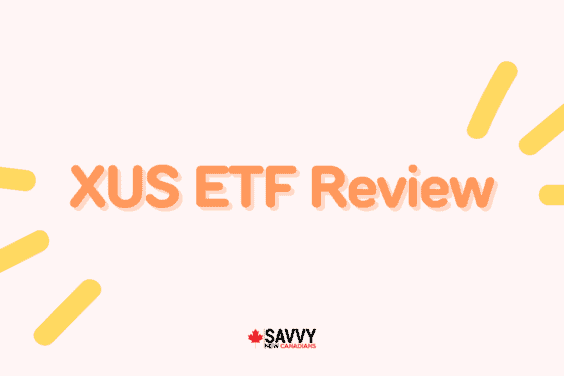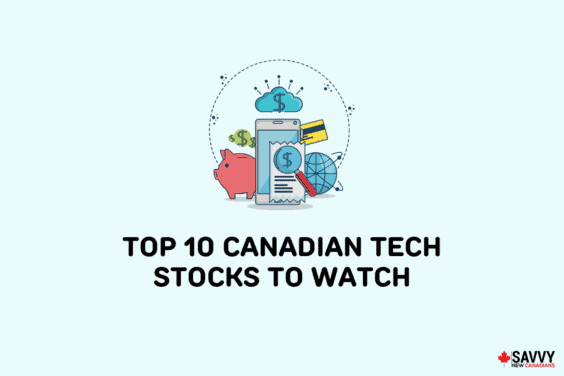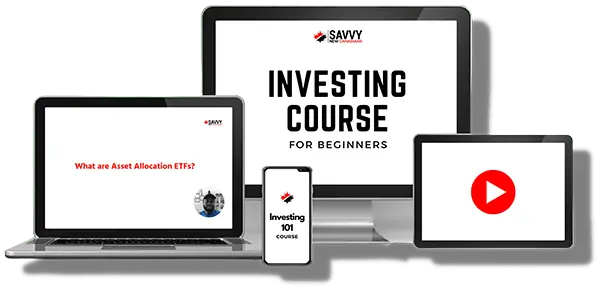Investing can be intimidating for beginners who do not have a lot of initial capital. It might seem like all the great companies you want to invest in have expensive stock prices.
On top of that, in Canada, the big bank brokerages are known for having high trading fees. Luckily for you, it is now easier than ever to start investing in Canada with little money.
With things like fractional investing and low-commission trading on discount brokerages, investing is more accessible than ever before.
In this article, we will discuss the best ways to start investing with little money in Canada in 2024.
How To Invest With Little Money in 2024
Invest in an All-in-One ETF
- Minimum Investment Amount: No minimum with fractional shares
- Risk Level: Low to Medium
With the introduction of Exchange Traded Funds or ETFs in Canada in 1990, the investment landscape was changed forever. Over the years, ETFs have evolved, and you can now invest in what is known as an all-in-one ETF.
All-in-one ETFs are funds designed to replicate an entire investment portfolio in a single asset. Instead of holding individual stocks, these ETFs hold a basket of other ETFs.
This provides investors exposure to thousands of underlying stocks and bonds and helps to build a ‘set it and forget it’ portfolio.
So what are the downsides to an all-in-one ETF? Typically you will not see outsized gains when holding a portfolio of ETFs. You will also pay an MER or Management Expense Ratio for owning shares of the ETF. This can eat into your future gains as your position grows over time.
- Minimum Investment Amount: $1.00 on Wealthsimple Trade
- Risk Level: Low to Medium, depending on the stocks you buy
Fractional investing is another game-changer for Canadian investors. This system allows you to purchase less than a full share of a particular stock or ETF and is particularly helpful for those who wish to start investing with little money.
Currently, the only brokerages where Canadians can buy fractional shares are Wealthsimple Trade and Interactive Brokers. This helps new investors to contribute minimal amounts and still invest in some of the best stocks and ETFs on the market.
The downside to buying fractional shares is that not every stock or ETF is available to investors. Also, most Canadian brokerages do not offer fractional investing.
Setup Automated Investing With a Robo-Advisor
- Minimum Investment Amount: It varies per service
- Risk Level: Low to Medium
Robo-Advisors are another helpful invention for investors with little money. As the name suggests, a Robo-Advisor is a service offered by brokerages that automatically invests your money for you. Depending on your preferences and investment goals, Robo-Advisor will build you a customized portfolio.
Wealthsimple’s Invest platform helps you build a custom portfolio starting with as little as $1.00. These Robo-Advisors primarily invest in low-cost ETFs and mutual funds.
The downside is that the management fees can be higher than managing your portfolio yourself. Rather than owning a basket of ETFs, you could just buy a lower-cost all-in-one ETF instead.
Use a Spare Change Investment App
- Minimum Investment Amount: None
- Risk Level: Low to Medium
Spare change investment apps are a great way to save small amounts of money and redeploy this change into investments. These apps are perfect for those who wish to keep adding small amounts to investments over time.
Rather than keeping those spare coins in a jar, apps like Moka and Wealthsimple’s RoundUp can really help you contribute to investments without even thinking about it.
You can specify how much change to invest and even top up your purchases to the nearest dollar and add the difference to your investments.
These apps do have some downsides. First, even if you only contribute your spare change, it likely will not amount to a significant investment. There are also some fairly high fees for using these services, especially considering the small amounts that are contributed.
Contribute To Your Workplace Pension Plan
- Minimum Investment Amount: Varies per employer
- Risk Level: Low
There are few financial tools more powerful than a workplace pension plan. Most employers will allow you to contribute a portion of your paycheque to the pension plan each pay period. If you are lucky, your employer will even match that contribution up to a certain amount.
When you retire, all of those years of contributing to your pension will finally pay off. You will receive a monthly distribution for the rest of your life. This is a critical part of maintaining your quality of life in retirement.
The obvious downside to a pension plan is you do not receive any payments until you retire. It might seem like a long wait, but it will be well worth it when that income hits your account each month.
Use Your TFSA and RRSP
- Minimum Investment Amount: None
- Risk Level: Low to Medium, depending on the stocks you buy
Utilizing Canadian registered accounts can help secure your gains over the long run. These accounts are tax-friendly and are intended to allow Canadians to invest and save without being taxed at the time of purchase.
Tax-Free Savings Accounts or TFSAs are completely tax-free, so any capital gains or dividends earned will not be considered taxable. As of 2023, the lifetime contribution limit for TFSAs is a cumulative amount of $88,000.
Registered Retirement Savings Plans or RRSPs are tax-deferred investments. You will not be taxed on any capital gains or dividends until you sell the assets in retirement.
Both accounts have benefits and disadvantages. TFSAs are limited to a set contribution amount each year, although you can carry forward contributions to another year. RRSPs defer taxes until they are cashed out, but you will eventually need to pay taxes on your gains.
Use a High-Interest Savings Account or GIC
- Minimum Investment Amount: Varies by the financial institution
- Risk Level: Low
These are two of the least risky ways to invest with little money. A high-interest savings account pays out a higher interest rate on the money it holds. A Guaranteed Investment Certificate is a secured term investment. At the end of the term, you receive back your initial investment plus any interest earned.
Both of these are considered extremely safe investments. GICs typically require a minimum investment amount which varies depending on the financial institution. Most are between $500 and $1,000.
Both assets are great for risk-averse investors who do not want to lose any money. The downside is that the returns are limited and usually trail the returns of assets like stocks and ETFs.
Start a Business
- Minimum Investment Amount: High
- Risk Level: High
Starting a business in Canada is an excellent way to invest your money. It is also one of the riskiest. To be fair, the risk level and minimum investment depend on the industry and type of work your company does.
There is a high level of initial investment into a business, especially ones that are capital intensive. For Canadians who wish to start investing with little money, starting a business is probably not advisable if they are unwilling to lose money.
Invest in Yourself
- Minimum Investment Amount: Varies
- Risk Level: Low
Some say there is no better investment than investing in yourself. This can be anything from being health-conscious to improving your education.
For those who wish to start investing with little money, the best way to improve yourself is to study different investment strategies.
Another good way to invest in yourself is to add more income streams. This might take some work, but the extra money can go a long way in increasing your investments.
Invest in Peer-to-Peer Lending
- Minimum Investment Amount: Varies
- Risk Level: High
Peer-to-Peer lending is exactly as it sounds: loaning money directly to another person without having a bank as the middleman. There are plenty of sites in Canada that facilitate peer-to-peer lending with see interest rates and terms.
The apparent downside to peer-to-peer lending is if the loanee defaults or refuses to repay the loan. Also, these peer-to-peer lending sites usually have high fees and rates that they take from each transaction.
Consider Passive Real Estate Investing
- Minimum Investment Amount: Low to Medium
- Risk Level: Low to Medium
Have you ever heard of Real Estate Investment Trusts or REITs? They are assets which trade on the major stock exchange that provide direct exposure to real estate. These companies own large amounts of real estate and collect rental income, which is then distributed to shareholders.
A large number of REITs pay out distributions every month. How can they pay out so much to shareholders? To qualify as a REIT, these companies must pay out at least 90% of their taxable income. In exchange, they do not pay any corporate income tax.
Setup Regular Contributions To a Mutual Fund
- Minimum Investment Amount: Varies
- Risk Level: Low to Medium
Generally speaking, mutual funds are considered low-risk assets. Like ETFs, mutual funds tend to track broader indexes or sectors. Similar to fractional shares, you can invest small amounts into mutual funds, usually with a minimum of just $50.
Mutual funds are great for beginner investors with little money. The downside to these assets is that they are actively managed by fund managers, so the management fees are higher than ETFs.
How to Invest as a Beginner
Make a Budget and Cut Expenses
What is the easiest way to increase your investable money? By spending less. For anyone who has not done a budget assessment, you will be surprised at the number of expenses you can cut.
One of the most popular ways to cut expenses is to make your coffee and breakfast at home before going to work. Even saving $5 daily can leave you $150 every month or about $1,800 every year that you can contribute to your investments!
Pay Off High-Interest Debt
Debt is a controversial topic when it comes to personal finance. On the one hand, high-interest debt can stifle your ability to grow your wealth. But on the other hand, low-interest debt can be used to boost your financial situation.
If you want to begin investing, you should first rid yourself of high-interest debt like credit card debt or personal loans. These high-interest debts can mitigate any gains you make from investing and act as an anchor to your finances.
Assess Your Risk Tolerance
This is one of the first things you need to ask yourself before you begin investing. Your risk tolerance will directly impact how you construct your portfolio and the types of assets you invest in.
There is no shame in having a low-risk tolerance, either. Not everyone wants to trade options or meme stocks. If you are averse to losing your money, there are plenty of safer investments to make.
Automate Contributions
If you want to get serious about investing, you need to start automating the contributions to your account. Why? Because this provides a constant and continuous cash flow that can help grow your investments.
This also stops you from spending this money before it even hits your bank account. This also establishes a nice routine where you can add to your investments after each paycheque.
Establish Your Financial Goals
Similar to assessing your risk tolerance, establishing your financial goals will play a large part in how you invest.
Are you investing for retirement? Or for your children? Or to buy a house? Whatever your financial goals may be, starting to invest is the first step toward achieving them.
Save on Investment Fees
If there is one thing to know about investing with different brokerages, it is the amount of fees you pay. Canadian brokerages are notorious for their high commission fees. Paying for each trade can have a major impact on your long-term gains.
Investing with a platform like Wealthsimple can save you hundreds or even thousands of dollars over time. Other sites like Questrade, QTrade, and CIBC Investor’s Edge also provide discounted fees that can help you realize your financial goals a little faster.
Think Long-Term
There are few ways to generate wealth better than holding stocks and ETFs for the long term. It is why they say that time in the market beats timing the market. When you begin investing, think about holding these investments for years.
When you can wrap your head around long-term investing, you worry less about what the stock market does daily.
FAQs
If you are just starting with investing, the best investments are usually index funds or broad-sector ETFs. These funds provide you with exposure to an entire basket of assets that create a solid foundation for your portfolio. Index funds typically do not see much volatility and can provide steady returns and dividends.
Yes! You can start investing with as little as $1.00 on platforms like Wealthsimple. Invest what you can afford and adding small amounts of money each week or month can bring you one step closer to achieving your financial goals.
If you have $1,000, you can invest on any brokerage in Canada. Buying shares of an all-in-one portfolio ETF or index fund is a great way to start.
Related:
